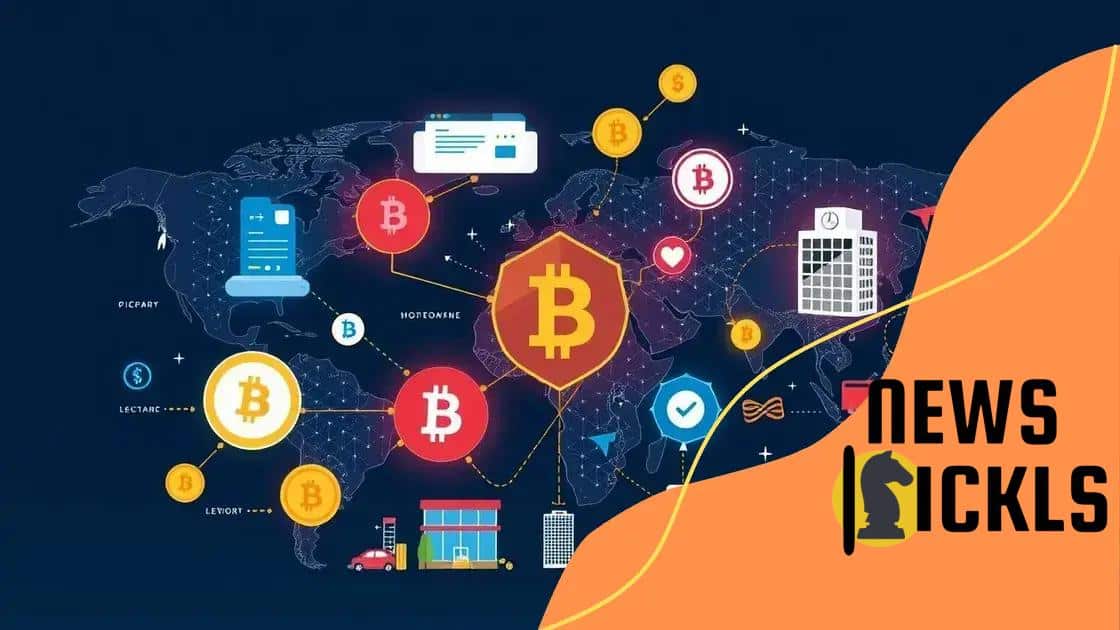How blockchain enhances security in global payment systems

Blockchain enhances security in global payment systems by providing encrypted transactions, reducing fraud risks, and enabling faster cross-border payments, making financial transactions more efficient and reliable.
How blockchain enhances security in global payment systems is a hot topic right now. With increasing concerns about fraud and data breaches, it’s worth exploring how this innovative technology can help secure transactions more effectively. Have you wondered how it might change your experience?
Understanding blockchain technology
Understanding blockchain technology is crucial to grasp how it strengthens security in payment systems. At its core, blockchain is a digital ledger that records transactions across many computers in a way that ensures security, transparency, and integrity.
This decentralized nature makes it difficult for hackers to alter any single record without the agreement of all parties involved. Therefore, many financial institutions are looking towards blockchain as a key solution.
Key Features of Blockchain
Blockchain technology offers several key features:
- Decentralization: No central authority controls the system, reducing the risk of fraud.
- Transparency: All transactions are visible to participants, promoting trust.
- Immutability: Once a transaction is recorded, it cannot be changed, ensuring data integrity.
These features are what make blockchain a promising option for global payments. Instead of relying on traditional centralized systems, blockchain introduces a new paradigm where everyone has access to the same transaction history.
How Does It Work?
Blockchain works through the use of cryptography. Each transaction is encrypted and linked to the previous transaction. This forms a chain of blocks—hence the name blockchain. Since every participant has a copy of the entire blockchain, it ensures that no single entity can corrupt the system.
The process begins when a transaction occurs. This transaction is verified using the distributed network of computers. Once confirmed, it gets added to a block. After this block is filled, it is added to the existing chain. This ensures all changes are recorded and secure.
By using blockchain, payment systems can become significantly more secure and efficient. It minimizes the chances of human error and fraud, making it a reliable choice for international transactions.
Key benefits of blockchain for payments
The key benefits of blockchain for payments are revolutionizing how transactions occur across the globe. By leveraging blockchain technology, payment systems can offer enhanced security, speed, and cost efficiency.
One major advantage is the reduction in transaction costs. Traditional payment methods often involve multiple intermediaries, each taking a fee. Blockchain simplifies this by enabling direct transfers between parties, cutting out the middlemen.
Enhanced Security
Security is significantly increased through the use of encryption and decentralization. Every transaction is encrypted and stored across a network of computers, making it nearly impossible for fraud to occur. Moreover, the transparency of the blockchain allows users to verify transactions without exposing sensitive information.
- Data integrity: Changes cannot be made to a recorded transaction without consensus, ensuring accuracy.
- Fraud prevention: The need for intermediaries is eliminated, reducing the risk of fraud.
- Real-time tracking: Users can track their transactions in real-time, which builds trust.
Another benefit is the speed of transactions. Traditional cross-border payments can take several days to process. With blockchain, transactions can be completed within minutes, which is ideal for global commerce.
Global Accessibility
Blockchain also promotes greater accessibility in the payments landscape. It allows people in areas with limited banking infrastructure to participate in the global economy. All that is needed is an internet connection and a digital wallet.
Furthermore, the use of cryptocurrency in blockchain transactions can bypass currency exchange fees, making international transactions more affordable.
As businesses increasingly adopt blockchain for payments, they are finding that the advantages can lead to improved customer experiences, fostering loyalty and increasing sales.
Real-world applications in global payments

Real-world applications in global payments showcase how blockchain technology is changing the landscape of financial transactions. Businesses and organizations worldwide are adopting this innovative approach to enhance efficiency, reduce costs, and improve security.
One prominent example is the use of blockchain in cross-border payments. Traditional methods can be slow and expensive, often taking days to complete and involving various intermediaries. In contrast, blockchain allows for near-instant transfers, helping businesses operate more smoothly.
Examples of Blockchain in Action
Several companies are successfully utilizing blockchain technology for payment solutions:
- Ripple: This digital payment protocol enables secure and fast international money transfers.
- Stellar: Focusing on providing financial services to underserved populations, Stellar connects banks and payment systems.
- IBM Blockchain: IBM’s blockchain solution facilitates cross-border payments, allowing companies to send and receive payments easily.
These applications illustrate how organizations are leveraging blockchain to make transactions faster and more reliable. Furthermore, many large companies are investing in blockchain technology to enhance their payment processes, offering customers better service.
Benefits for Merchants and Consumers
Merchants benefit from lower transaction fees and quicker access to their funds. Consumers enjoy faster transaction times and enhanced security during payments. These advantages contribute to a more trustworthy financial ecosystem, promoting wider adoption of blockchain in daily transactions.
For instance, companies like Overstock and Shopify are already integrating blockchain technology for their payment systems, allowing customers to pay using cryptocurrencies with ease. This trend shows how blockchain is not just a theory but a practical solution being implemented across various sectors.
Challenges in implementing blockchain
Implementing blockchain comes with a set of challenges that can hinder its adoption in global payments. Understanding these obstacles is essential for businesses looking to transition to this technology.
One significant challenge is the lack of standardized regulations. Different countries and regions have varying laws regarding cryptocurrencies and blockchain technology. This inconsistency creates confusion for businesses trying to navigate these rules, which can slow down implementation.
Technical Complexity
Blockchain systems can also be technically complex. Many traditional financial institutions lack the technical expertise needed to develop and maintain a blockchain infrastructure. This knowledge gap means that companies often need to invest in training or hire specialized professionals.
- Integration with existing systems: Merging blockchain with current payment systems can be difficult and costly.
- Scalability issues: As transaction volumes grow, some blockchain networks may struggle to maintain speed and efficiency.
- Data privacy concerns: While transparency is a benefit, it can raise privacy issues for consumers’ sensitive information.
Another issue is the energy consumption associated with blockchain technology, especially in networks that require a lot of computational power for transaction verification. This energy demand raises concerns about sustainability in an increasingly eco-conscious world.
Market Resistance
Finally, there is often resistance from within organizations to adopt new technologies. Employees may be hesitant to change established systems and workflows, leading to pushback against adopting blockchain. Overcoming this reluctance takes time and effective change management strategies.
Despite these challenges, many companies are actively working to overcome these hurdles. By investing in education and technology, organizations can position themselves to take advantage of the numerous benefits that blockchain offers.
Future trends in payment systems
Future trends in payment systems are increasingly influenced by technology, especially blockchain. As this innovative technology evolves, it is shaping how transactions are processed and managed around the world.
One major trend is the growing acceptance of cryptocurrencies as a valid form of payment. Many businesses are starting to integrate digital currencies into their payment systems. This shift towards cryptocurrencies opens new opportunities for faster and more efficient transactions.
Integration with Artificial Intelligence
An exciting development is the integration of artificial intelligence (AI). AI can analyze transaction data, detect fraud, and offer personalized payment solutions. This advancement helps improve security while enhancing user experiences.
- Fraud detection: AI systems can learn from transaction patterns and identify suspicious activities more quickly than manual methods.
- Customer service: Chatbots powered by AI can assist customers with payment queries in real-time.
- Payment recommendations: AI can provide suggestions for payment methods based on user behavior, leading to a more personalized experience.
Another trend is the adoption of mobile payment solutions. With more people using smartphones for their daily transactions, mobile wallets are becoming popular. These apps allow users to pay for services quickly and securely without needing physical cash or cards.
Emphasis on Security and Privacy
As digital payments grow, so does the emphasis on security and privacy. Users want to trust that their data is safe. In response, payment systems are prioritizing secure technologies, like biometric authentication (fingerprints or facial recognition) and advanced encryption methods.
Furthermore, there is a potential rise in decentralized finance (DeFi) solutions that leverage blockchain to create open-source financial services. This movement aims to make financial services more inclusive and accessible to everyone.
To sum up, the future of payment systems is bright as they evolve with technology. The combination of blockchain, AI, mobile payments, and stringent security measures will redefine the landscape, making transactions faster, safer, and more user-friendly.
In conclusion, the future of global payment systems is being transformed by blockchain technology. As we move forward, we can expect to see more businesses embrace cryptocurrency integration and mobile payment solutions. With the power of artificial intelligence enhancing security and efficiency, consumers will benefit from faster and safer transactions. However, addressing challenges like regulation and technical complexity will be essential. Overall, the evolution of payment systems promises a more inclusive and streamlined financial experience for everyone.
FAQ – Frequently Asked Questions about Blockchain in Global Payment Systems
How does blockchain improve transaction speed?
Blockchain allows for near-instantaneous transactions, eliminating the need for intermediaries that slow down the process.
What are the security benefits of using blockchain?
Blockchain enhances security by encrypting transactions and storing them across a distributed network, making it difficult for fraud to occur.
What challenges do businesses face when adopting blockchain?
Businesses often encounter regulatory confusion, technical complexity, and market resistance that can slow down adoption.
Are cryptocurrencies becoming more widely accepted for payments?
Yes, more businesses are integrating cryptocurrencies into their payment systems, increasing acceptance across various sectors.






